Patty loves her beautiful mom, Rose Ann. Here they are at the Soul of Creativity event held recently at Breezeway.

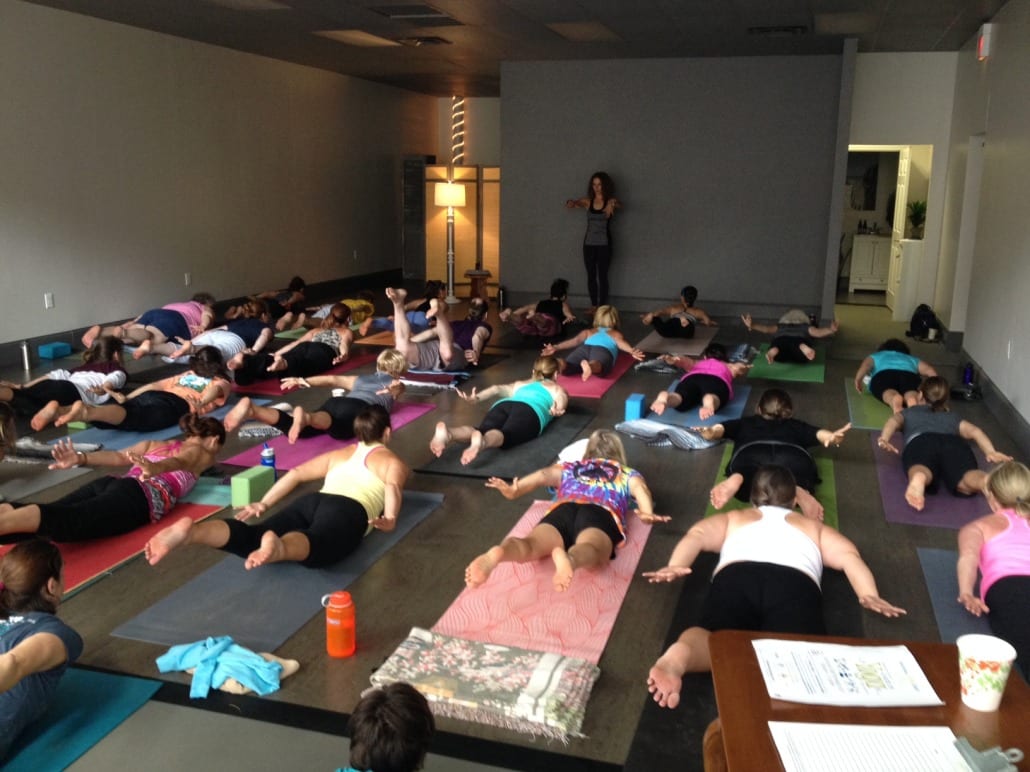
By DANIELLE ZOELLNER FOR DAILYMAIL.COM
 Researchers from HG SMS Hospital in Jaipur, India, presented the study at the 8th Emirates Cardiac Society Congress in collaboration with the American College of Cardiology Middle East Conference.
Researchers from HG SMS Hospital in Jaipur, India, presented the study at the 8th Emirates Cardiac Society Congress in collaboration with the American College of Cardiology Middle East Conference.
The study looked at 750 patients who had previously been diagnosed with coronary heart disease.
One group of 225 patients participated in aerobic exercise, another group of 240 patients participated in yoga, and a third group of 285 participated in both yoga and aerobic exercise.
Each group did three, six-month sessions of their assigned exercises.
Yoga was picked as one the the forms of exercise because of its practice of strengthening the body, mind and soul.
Researchers wanted to see if yoga and aerobic exercise would have an effect on coronary risk factors of obese patients with type 2 diabetes.
The findings showed that aerobic exercise only and yoga only groups showed similar reductions in blood pressure, total cholesterol, triglycerides, LDL, weight and waist circumference.
However, the combined yoga and aerobic exercise group showed a two times greater reduction compared to the other groups.
They also showed significant improvement in left ventricular ejection fraction, diastolic function and exercise capacity.
‘Combined Indian yoga and aerobic exercise reduce mental, physical and vascular stress and can lead to decreased cardiovascular mortality and morbidity,’ said co-authors Dr Sonal Tanwar, a scholar in preventative cardiology, and Dr Naresh Sen, a consultant cardiologist, both with HG SMS Hospital.
‘Heart disease patients could benefit from learning Indian yoga and making it a routine part of daily life.’
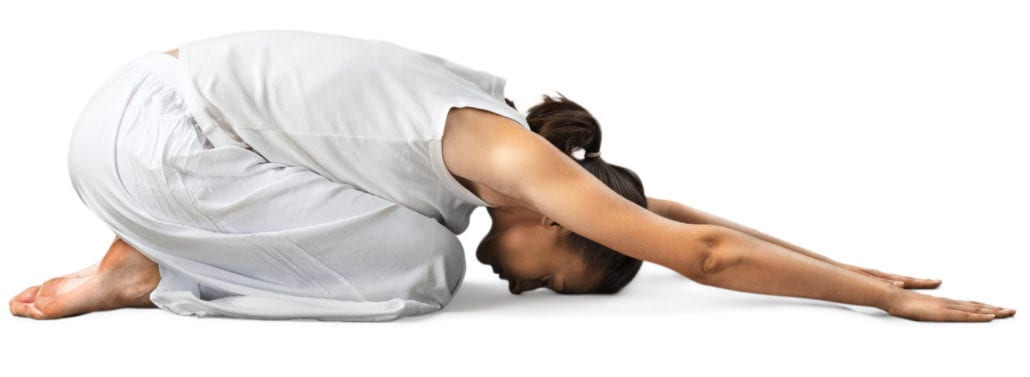
For centuries yoga has been used to increase strength and flexibility, as well as improve mind/body alignment and reduce stress. Solid benefits all, but they’re just a sampling of how yoga can improve everyday living. Here’s a breakdown:
Whether you’re 8 years old or 80, a diehard gym-every-day athlete or a weekend warrior looking to up your exercise game, yoga can help. Regular yoga practice gets you in touch with your entire body as you move through the poses and flows. And when you’re more in touch with areas that are tight or sore, it’s more likely you’ll pay attention to what’s hurting before a potential injury becomes a real one.
In the same way yoga helps prevent injuries, it also can serve as a safe way to get back into a fitness program following time away. For example, if you’ve had to step away from exercise due to injury and aren’t ready for high-impact activity yet or are recovering from illness or surgery — or even just living a busy life — yoga can serve as a fun, low-impact way to ease back into movement.
In particular, look into restorative yoga. There all many types and levels of yoga classes, and restorative is great for beginners and longtime practitioners alike. The focus here is working on basic poses and holding them for enough time to help joints and muscles relax and loosen. It also increases blood flow and improves flexibility.
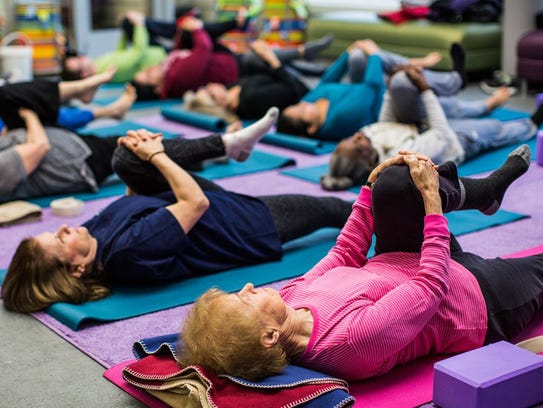 Yoga is also a fantastic fitness option as we age. As a low-impact exercise, it’s good for anyone dealing with sore hips, knees or other joints. At the same time, yoga lets you work up enough of a sweat to help ditch those hard-to-shed pounds and build flexibility and strength that we often lose with age.
Yoga is also a fantastic fitness option as we age. As a low-impact exercise, it’s good for anyone dealing with sore hips, knees or other joints. At the same time, yoga lets you work up enough of a sweat to help ditch those hard-to-shed pounds and build flexibility and strength that we often lose with age.
For 89-year-old Dean Stevens, the free yoga class she attends weekly at the Nashville Public Library, run by Small World Yoga and part of Be Well at NPL, has given her a newfound stability she says her peers are often lacking.
“So many of my friends are falling,” she explains. “I almost fell in the strawberry patch the other day, but because I have better flexibility and control over my body, I was able to recover. And that’s because of yoga.”
There are sound psychological and emotional benefits to yoga as well. This is good news for anyone battling depression, anxiety and other mental-health issues. A low-key, dependable exercise regimen such as yoga can:
• Improve balance and stability
• Strengthen muscles
• Increase flexibility
• Improve joint health
• Support better respiration
• Reduce high blood pressure
• Lower anxiety
Yoga brings all those benefits to anyone who rolls out a mat and starts building a personal practice.
And that’s another beauty of yoga: It’s called “practice” because it’s about being quiet, calm and focused rather than accomplishing a set-lifting goal or number of reps. In that way, yoga encourages mindfulness, so you can connect with your body as you flow your way to better health.
The intent of yoga is to link the body and mind. Yoga instructors cultivate the idea of directing our attention and intention to the body, to its movement in the present moment, and to our breathing. Yoga is also a good way to strengthen attention through mindfulness.
This story is provided and presented by BlueCross BlueShield of Tennessee.
SaveSave
Join Sandra Smith, M.Div., and Annie Wills, Ed.D, for a two day workshop starting Friday October 27th at 1:00 – 4:00 PM and continuing on Saturday, October 28th, 9:00AM – 4:30PM. Breakfast and lunch provided on Saturday. $75.00 per participant.
The workshop will be held at Bridgewater Place, 205 Bridgewater Road, Knoxville, TN 37923.
To register, call UT Internal Medicine and Integrative Health: 865-971-3539.
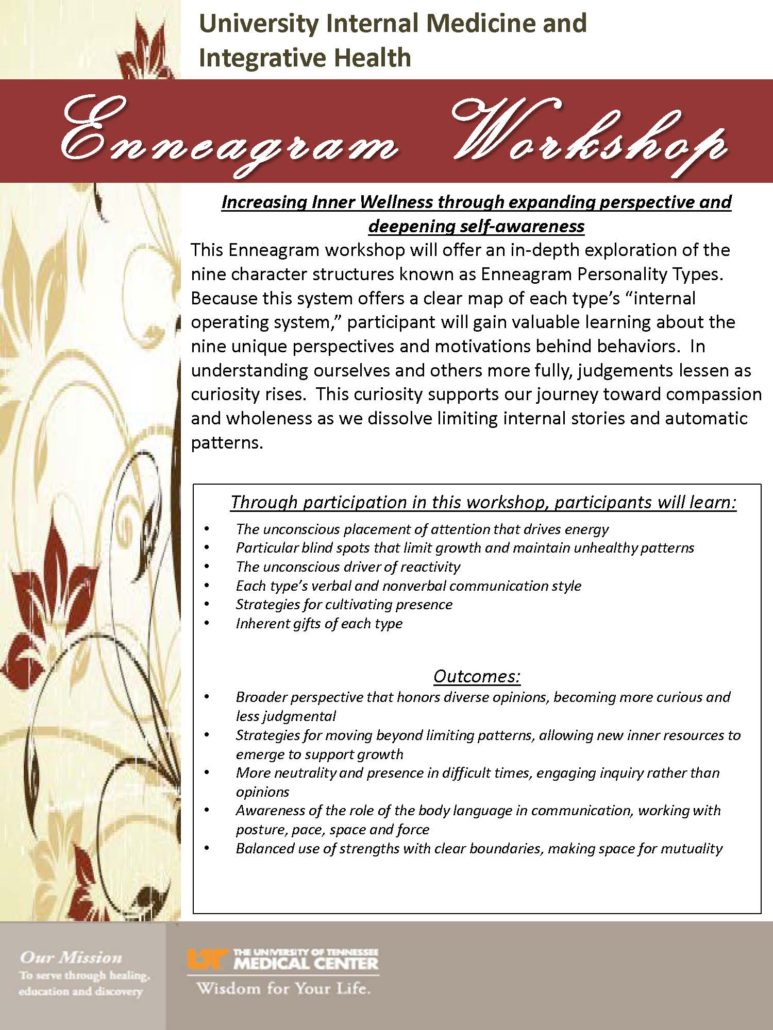
http://www.knoxnews.com/story/entertainment/2017/06/15/pilates-paws-core-exercises-mix-adorable-adoptable-kittens/387859001/
Proper breath control easily dissolves into giggles when a pair of gray and white kittens called Angela and Pam race across a yoga studio floor.
This is Pilates with kittens at Breezeway Studios in Knoxville on a Sunday morning. Instructor Susie Kaplar gives her 18 students instructions in stretching, twisting, breathing – and animal contact.
“When a kitten plops on your stomach, you are going to stop and pet a kitten,” she says.
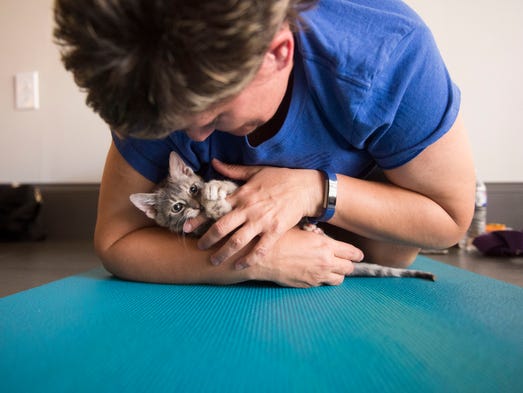
The hourlong session was the fifth in Young-Williams’ summer “Kitten Yoga” series. Held at different exercise studios, the classes teach yoga or Pilates while kittens run, prance, stalk and sit among the exercise mats.
This Pilates class is a combination of stretching your spine and petting a kitten or twisting your torso and cuddling a cat. The humans, including myself, paid $15 each to perform core-strengthening exercises among the free-roaming felines.
Young-Williams volunteer Azura Miller made two trips to the center to bring the agile, adoptable kittens to the studio. The 2- to 3-months-old cats were a silver tabby named Dexter, three nearly identical gray kittens called Pudge, Angela and Pam and the calico trio of Blondi, Yakko and Wakko.
Young-Williams began Kitten Yoga after Development Coordinator Sophie Nguyen heard about a similar class in Louisville, Ky. When the first class sold out quickly, more were added.
For Sunday’s Pilates, we humans began stretched out on rubber mats on the studio floor, putting us at kitten level. Miller and Young-Williams volunteers Allison Murray and Grace Malone removed the kittens from plastic or cardboard carriers. They scattered ping pong balls and catnip-stuffed mice in the middle of the floor, instantly drawing the cats’ attention.
We humans raised our spines slowly into a Pilates bridge. The felines chased the ping pong balls and batted the toy mice, often more interested in each other and their toys than the humans moving around them.
We humans pushed up on their hands to perform planks. The cats jumped over our outstretched legs and dashed under our raised abdomens. As a row of women bicycled their legs in the air, tiny calico Blondi sat quietly to watch wide eyed.
Mandi Bergeron’s pink sneakers were a kitty magnet. As she exercised, Bergeron sometimes jangled one shoe’s laces in the air as Blondi and gray kitty Pudge took turns swatting at the swinging strings.
Miller, Murphy and Malone got their own cardio workouts as they repeatedly retrieved the kittens when the cats ran into a small back room of the studio.
Most class participants were familiar with yoga or Pilates, and many were pet owners. “Kittens are the extra perk,” sad Maddie Holtzclaw.
“I love animals and I like to exercise,” said South College student Allie Smith, who owns three dogs. “Put the two together and it’s irresistible.”
Since the classes don’t include on-site adoptions, all the kittens returned at least temporarily to Young-Williams on Sunday. At least two class participants expressed interest in adopting kittens. Cats who participated in the past four sessions have been adopted but Nyugen didn’t know if yoga or Pilates participants adopted the animals.
The next Kitten Yoga sessions are 11:30 a.m. June 17, and Sunday, June 18 at Bullman’s Kickboxing & Krav Maga, 4589 Kingston Pike. Cost is $20. The series also includes two July sessions; those dates aren’t set.
Young-Williams has raised more than $1,000 from the classes, Nguyen said. The classes also raise awareness for the shelter. “They let people know about kitten season in general and that we need supplies and we need people to come and adopt,” she said.
SaveSave
SaveSave
SaveSave
SaveSave
SaveSave
SaveSave
SaveSave
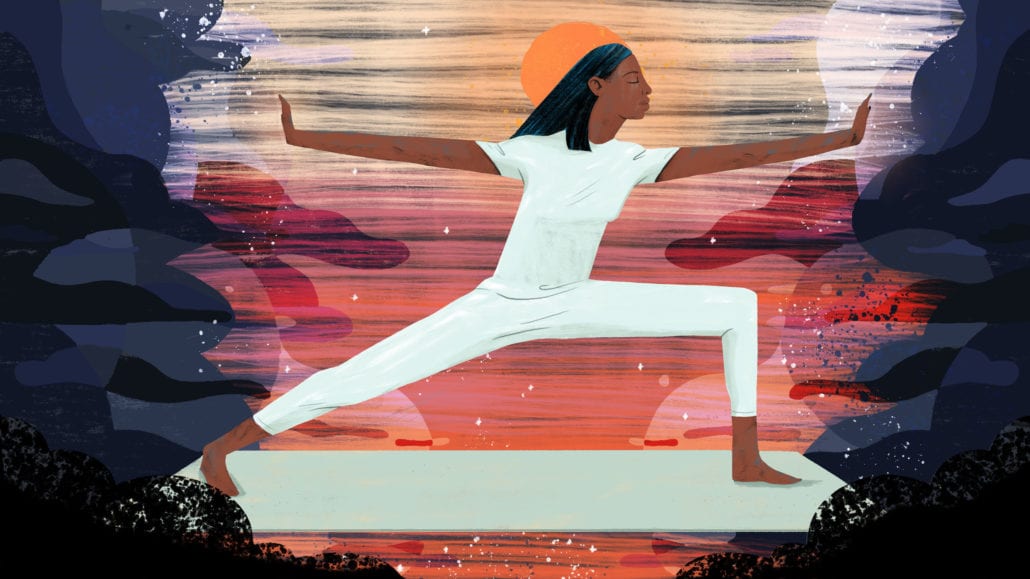
Originally posted here on NPR.org
Missy Hart grew up in Redwood City, Calif. — in gangs, on the street, in the foster care system and in institutions.
“Where I’m from,” the 26-year-old says, “you’re constantly in alert mode, like fight or flight.”
But at age 13, when she was incarcerated in juvenile hall for using marijuana, she found herself closing her eyes and letting her guard down in a room full of rival gang members.
Back then, she says, yoga was just another mandatory activity, run by a Bay Area program called The Art of Yoga Project. It offers what it calls “trauma-sensitive yoga” to incarcerated girls.
At first, 13-year-old Hart felt uncomfortable. But, gradually, she learned to use the poses and breathing to relax, and she loved it.
“Most of us [in juvenile hall] come from traumatic childhoods,” she says. “It was the only time you experienced a quiet time, when everything was so chaotic.” She believes the practice helped her cope with symptoms of bipolar disorder.
A new report from the Center on Poverty and Inequality at Georgetown University’s law school, says that for young women like Hart, who have been through trauma, there is mounting evidence that yoga can have specific benefits.
The study focuses on girls in the juvenile justice system. It also reviews more than 40 published studies on the mental health benefits of yoga.
“What we’re learning,” says Rebecca Epstein, one of the report’s authors, “is that fights go down on wards after adolescents participate,” in yoga.
Girls, she adds, “are requesting medicine less often. They have fewer physical complaints.”
The findings, Esptein explains, come from speaking to experts in the field, as well as the authors of peer-reviewed articles and some randomized, controlled trials.
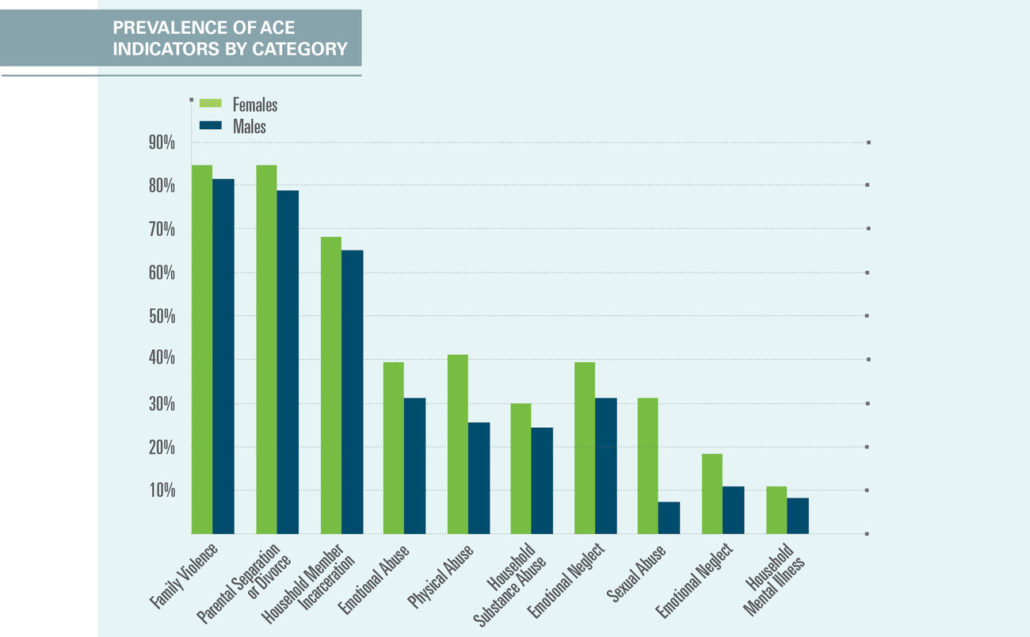
Two Georgetown pilot studies showed girls and young women who did yoga reported better self-esteem and developed skills that they could use in stressful situations — taking care of their own children, for example.
Educators and others who work with youth are, increasingly, paying attention to the science of trauma.
Large studies show that people who have been through one or more “adverse childhood experiences” have not only poor mental health outcomes, but also higher incidence of heart disease, diabetes and even some cancers. Those experiences might include such things as physical abuse, the incarceration of a close family member or mental illness in their household.
Further, statistics show that compared with boys, girls experience different forms of childhood trauma, with an impact that adds up over time. They disproportionately experience sexual violations, for example. And, for girls, this abuse is more likely to occur in the context of a relationship, Epstein says, which interferes with forming intimate and trusting relationships with others.
The new Georgetown Law report argues that, since the effects of trauma can be physical, “body-mind” interventions, like yoga, may be able to uniquely address them. Regulated breathing, for example, calms the parasympathetic nervous system. Practicing staying in the moment counteracts some of the dissociative effects of trauma. And the physical activity of yoga, of course, can directly improve health.
Yoga that is specifically designed for victims of trauma has modifications when compared with traditional yoga teaching.
For example, says Missy Hart, “they always ask you if you want to be touched,” for an adjustment in a pose. “I see now that really helped me. Other girls who have experienced sexual abuse, sexual trauma or are in there for prostitution at the age of 13, 14, they had their body image all mixed up.”
And the institution doesn’t always help, she says.
“Being asked to be touched, it gave us a little power back in a place where all our power is taken,” she explained. “We’re kids and we’re being strip-searched. We can’t even go to the bathroom, take a shower, or brush our teeth without asking.”
Yoga, she said, offered choices. “You can sit and reflect and think about what you want to think about. It helped us feel normal.”
When Hart turned 18, she was out of the foster care system, and became homeless for a time. “I was really searching for myself.”
Today, she is painting and studying to become an art therapist at Foothill College, near San Jose, Calif. She’s going back this summer to one of the institutions where she spent time as a girl, this time as an art teacher.
And, she is beginning her vinyasa yoga teacher training certification. Her ultimate goal, she says, is to open a group home that will offer creative arts and yoga. “When I was doing yoga, that seed was planted. I built my toolbox.”
http://www.local8now.com/content/news/New-guidelines-outline-how-to-treat-back-pain-414637613.html
KNOXVILLE, Tenn. (WVLT) – New guidelines from the American College of Physicians say the first line of therapy for back pain should be non-drug treatments.
Jay Dee Clayton finds peace from his pain through yoga.
“Whenever I start to feel a little twinge, I pull my knee out and stretch the area that’s giving me a problem and it dissipates. It goes away,” he said.
But, yoga wasn’t the first place he looked for relief.
“I took medication immediately after the surgery and I didn’t like feeling like my head was on a balloon string, so I looked for alternative methods of just managing through it,” he said.
Several months ago, Cecelia Aurand also went looking for relief.

“I’ve had spinal stenosis and back pain for quite a while,” she said.
She, too, first tried the prescription route.
“It didn’t really help. After I had the surgery it did help for a time but it didn’t last,” she said.
So, she turned to acupuncture where she says she saw immediate results.
“Within three sessions, I was walking normal again. It was amazing,” she said.
“Many people are able to reduce or completely discontinue the use of pharmaceuticals to manage pain because of acupuncture,” said Dr. Will Foster, an acupuncturist at Traditional Health Clinic.
The fact that both Clayton and Aurand were able to find relief outside of pain pills doesn’t surprise Dr. Samuel Yoakum.
“There are certain types of pain that pills treat really well. They don’t treat chronic back pain well,” he said.
New guidelines from the American College of Physicians back this up.
The guidelines say the first line of therapy for back pain should be non-drug treatments. For pain lasting less than three months, those include heat wraps, massage, acupuncture and spinal manipulation. The authors stress that clinicians should avoid costly and potentially harmful treatments like narcotics.
For pain lasting more than three months, treatments include stretching and strengthening exercises, tai chi, yoga, acupuncture, and mindfulness techniques like meditation to relieve stress.
If those fail, anti-inflammatories such as ibuprofen should be considered first, then medications that can dull nerve pain, like tramadol or duloxetine.
“Be as active as possible. That’s what we take from these guidelines more than anything else,” said Dr. Yoakum.
Not all insurances cover alternate therapies. It’s important to consult with your physician or a specialist to diagnose what type of back pain you have and what treatment plan would be best.
PROGRAM DESCRIPTION
It is amazing how only a couple days of silence can create a sense of self discovery and camaraderie. Our Slient Meditation and Yoga Retreats give participants the opportunity to connect with themselves and others at a deeper level beyond the usual discourse.
This weekend retreat will give you the opportunity to revitalize yourself, unclutter your mind, deepen your understanding of yourself and others, and discover sources of strength you may have only glimpsed but now can come to own. Silence allows you the time you always wanted to put things into perspective, find the balance, and recognize what the signs of your life are trying to tell you.
Silent Meditation and Yoga retreats at the Prama Institute are unique:
When: April 7 – 9, 2017
Location: Prama Institute
Program: Silent Yoga & Meditation Retreat
Faculty: Howard Nemon, Sid Jordan
Shared Accommodation
$350 (Till March 15), $395 (After March 15)
Private Accommodation
$450 (Till March 15), $495 (After March 15)